Temporal lobe seizures begin in the temporal lobes of your brain, which process emotions and are important for short-term memory. Some symptoms of a temporal lobe seizure may be related to these functions, including having odd feelings — such as euphoria, deja vu or fear.
Temporal lobe seizures are sometimes called focal seizures with impaired awareness. Some people remain aware of what's happening, but during more-intense seizures, you might look awake but be unresponsive. Your lips and hands may make purposeless, repetitive movements.
Temporal lobe seizures may stem from an anatomical defect or scar in your temporal lobe, but the cause is often unknown. Temporal lobe seizures are treated with medication. For some people who don't respond to medication, surgery may be an option.
Symptoms
An unusual sensation (aura) may precede a temporal lobe seizure, acting as a warning. Not everyone who has temporal lobe seizures has auras, and not everyone who has auras remembers them.
The aura is actually the first part of a focal seizure before consciousness is impaired. Examples of auras include:
- A sudden sense of unprovoked fear or joy
- A deja vu experience — a feeling that what's happening has happened before
- A sudden or strange odor or taste
- A rising sensation in the abdomen, similar to being on a roller coaster
Sometimes temporal lobe seizures impair your ability to respond to others. This type of temporal lobe seizure usually lasts 30 seconds to two minutes. Characteristic signs and symptoms include:
- Loss of awareness of surroundings
- Staring
- Lip smacking
- Repeated swallowing or chewing
- Unusual finger movements, such as picking motions
After a temporal lobe seizure, you may have:
- A period of confusion and difficulty speaking
- Inability to recall what occurred during the seizure
- Unawareness of having had a seizure
- Extreme sleepiness
In extreme cases, what starts as a temporal lobe seizure evolves into a generalized tonic-clonic (grand mal) seizure — featuring convulsions and loss of consciousness.
When to see a doctor
Seek immediate medical help if any of the following occurs:
- The seizure lasts more than five minutes.
- Breathing or consciousness doesn't return after the seizure stops.
- A second seizure follows immediately.
- Recovery isn't complete after the seizure is over.
- Recovery is slower than usual after the seizure is over.
- You have a high fever.
- You're experiencing heat exhaustion.
- You're pregnant.
- You have diabetes.
- You've injured yourself during the seizure.
If you experience a seizure for the first time, seek medical advice.
Seek medical advice in these circumstances:
- If you think you or your child is having seizures
- When the number or severity of seizures increases significantly without explanation
- When new signs or symptoms of seizures appear
Causes
Often, the cause of temporal lobe seizures remains unknown. However, they can be a result of a number of factors, including:
- Traumatic brain injury
- Infections, such as encephalitis or meningitis, or a history of such infections
- A process that causes scarring (gliosis) in a part of the temporal lobe called the hippocampus
- Blood vessel malformations in the brain
- Stroke
- Brain tumors
- Genetic syndromes
During normal waking and sleeping, your brain cells produce varying electrical activity. If the electrical activity in many brain cells becomes abnormally synchronized, a convulsion or seizure may occur.
If this happens in just one area of the brain, the result is a focal seizure. A temporal lobe seizure is a focal seizure that originates in one of the temporal lobes.
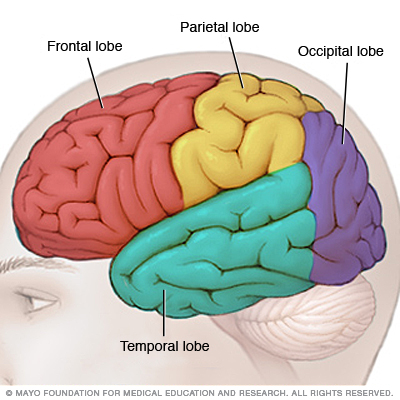
Each side of your brain contains four lobes. The frontal lobe is important for cognitive functions and control of voluntary movement or activity. The parietal lobe processes information about temperature, taste, touch and movement, while the occipital lobe is primarily responsible for vision. The temporal lobe processes memories, integrating them with sensations of taste, sound, sight and touch.
Complications
Over time, repeated temporal lobe seizures can cause the part of the brain that's responsible for learning and memory (hippocampus) to shrink. Brain cell loss in this area may cause memory problems.
Diagnosis
After a seizure, your doctor will thoroughly review your symptoms and medical history. Your doctor may order several tests to determine the cause of your seizure and evaluate how likely it is that you'll have another one.
Tests may include:
- Neurological exam. Your doctor may test your behavior, motor abilities and mental function to determine if you have a problem with your brain and nervous system.
- Blood tests. Your doctor may take a blood sample to check for signs of infections, genetic conditions, blood sugar levels or electrolyte imbalances.
- Electroencephalogram (EEG). Electrodes attached to your scalp record the electrical activity of your brain, which shows up as wavy lines on an EEG recording. The EEG may reveal a pattern that tells doctors whether a seizure is likely to occur again, or help rule out other conditions that mimic epilepsy.
- Computerized tomography (CT) scan. A CT scan uses X-rays to obtain cross-sectional images of your brain. CT scans can reveal abnormalities in your brain that might cause a seizure, such as tumors, bleeding and cysts.
- Magnetic resonance imaging (MRI). An MRI uses powerful magnets and radio waves to create a detailed view of your brain. Your doctor may be able to detect lesions or abnormalities in your brain that could lead to seizures.
- Positron emission tomography (PET). PET scans use a small amount of low-dose radioactive material that's injected into a vein to help visualize active areas of the brain and detect abnormalities.
- Single-photon emission computerized tomography (SPECT). A SPECT test uses a small amount of low-dose radioactive material that's injected into a vein to create a detailed, 3-D map of the blood flow activity in your brain that happens during a seizure. Doctors may also conduct a form of a SPECT test called subtraction ictal SPECT coregistered to magnetic resonance imaging (SISCOM), which may provide even more-detailed results.
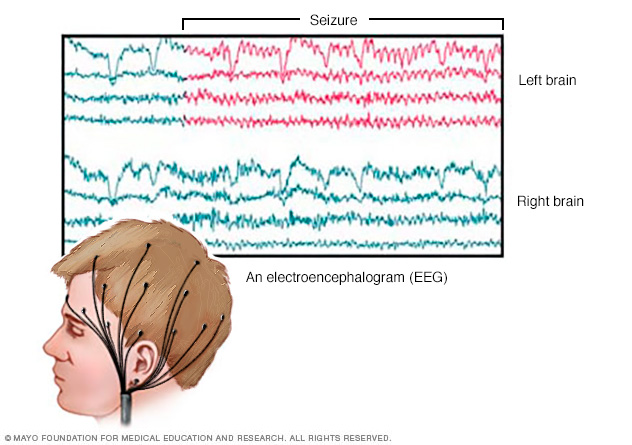
An EEG records the electrical activity of the brain via electrodes affixed to the scalp. EEG results show changes in brain activity that may be useful in diagnosing brain conditions, especially epilepsy and other seizure disorders.
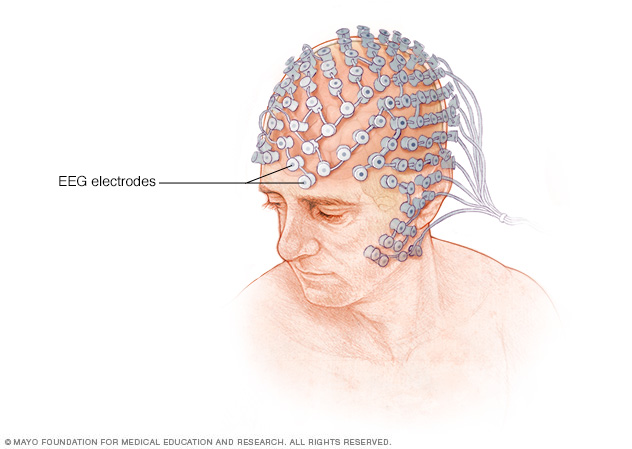
During a high-density EEG test, electrodes are placed on your scalp closely spaced together. Like conventional EEG, high-density EEG records brain activity. A high-density EEG test can help your doctor locate the area in your brain where seizures occur.
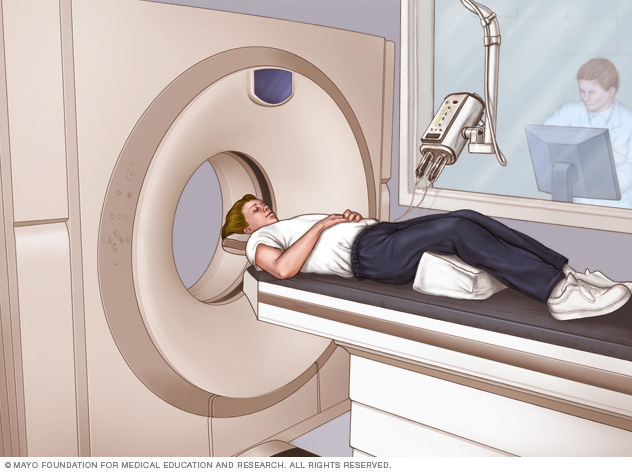
A CT scan can be used to visualize nearly all parts of the body and is used to diagnose disease or injury as well as to plan medical, surgical or radiation treatment.
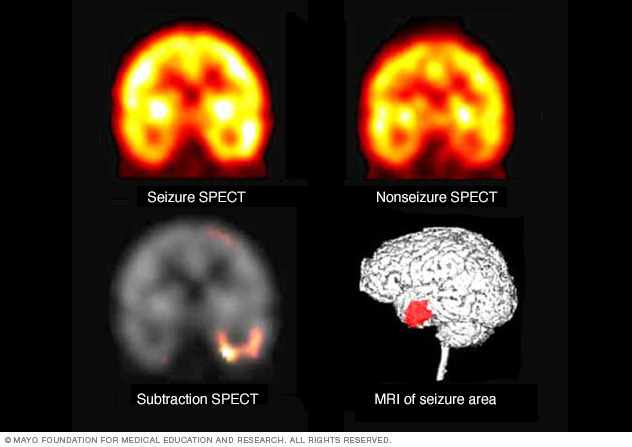
This example shows SPECT scans taken during and between seizures. The differences represent areas where blood flow increased during the seizure. Once identified, that location is fitted onto an MRI image of the brain.
Treatment
Not everyone who has one seizure will have another one. Because a seizure can be an isolated incident, your doctor may not decide to start treatment until you've had more than one.
The optimal goal in seizure treatment is to find the best possible therapy to stop seizures, with the fewest side effects.
Medications
Many medications are available to treat temporal lobe seizures. However, many people don't achieve seizure control with medications alone, and side effects, including fatigue, weight gain and dizziness, are common.
Discuss possible side effects with your doctor when deciding about treatment options. Also ask what effect your seizure medications and other medications you take, such as oral contraceptives, may have on each other.
Surgical or other procedures
When anti-seizure medications aren't effective, other treatments may be an option:
-
Surgery. The goal of surgery is to stop seizures from happening. This is often done through a traditional surgery, where surgeons operate to remove the area of the brain where seizures begin. In certain people, surgeons may be able to use MRI-guided laser therapy as a less invasive way to destroy the area of damaged tissue that causes seizures.
Surgery works best for people who have seizures that always originate in the same place in their brains. Surgery generally isn't an option if your seizures come from more than one area of the brain, your seizure focus can't be identified or your seizures come from a region of the brain that performs vital functions.
- Vagus nerve stimulation. A device implanted underneath the skin of your chest stimulates the vagus nerve in your neck, sending signals to your brain that inhibit seizures. With vagus nerve stimulation, you may still need to take medication, but you may be able to lower the dose.
- Responsive neurostimulation. During responsive neurostimulation, a device implanted on the surface of your brain or within brain tissue can detect seizure activity and deliver an electrical stimulation to the detected area to stop the seizure.
- Dietary therapy. Following a diet that's high in fat and low in carbohydrates, known as a ketogenic diet, can improve seizure control. Variations on a high-fat, low-carbohydrate diet, such as the low glycemic index and modified Atkins diets, may be less effective. However, they aren't as restrictive as the ketogenic diet and might provide some benefit.
Pregnancy and seizures
Women who've had previous seizures typically are able to have healthy pregnancies. Birth defects related to certain medications can sometimes occur.
In particular, valproic acid (Depakene) — one possible medication for generalized seizures — has been associated with cognitive deficits and neural tube defects, such as spina bifida. The American Academy of Neurology recommends that women avoid using valproic acid during pregnancy because of risks to the baby.
Discuss these risks with your doctor. Because of the risk of birth defects, and because pregnancy can alter medication levels, preconception planning is particularly important for women who've had seizures.
In some cases, it may be appropriate to change the dose of seizure medication before or during pregnancy. Medications may be switched in rare cases.
Contraception and anti-seizure medications
It's also important to know that some anti-seizure medications can alter the effectiveness of oral contraceptives — a form of birth control — and some oral contraceptives can speed up the absorption of seizure medications. If contraception is a high priority, check with your doctor to evaluate whether your medication interacts with your oral contraceptive, and if other forms of contraception need to be considered.
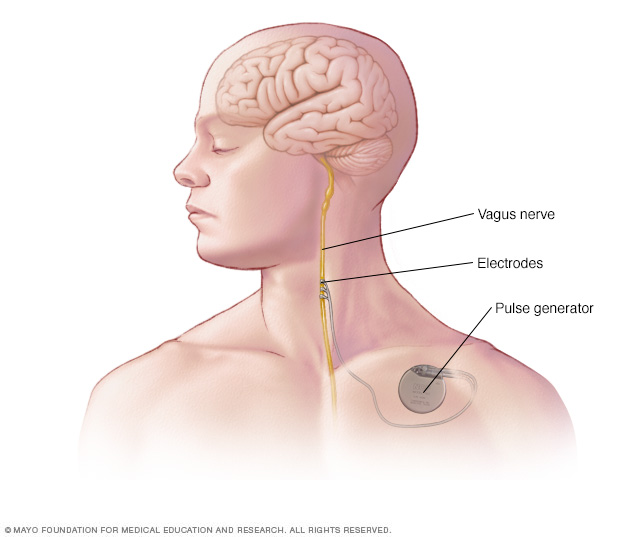
In vagus nerve stimulation, an implanted pulse generator and lead wire stimulate the vagus nerve, which leads to stabilization of abnormal electrical activity in the brain.
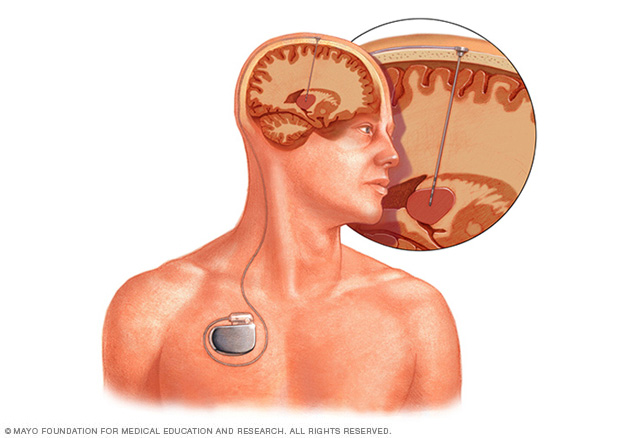
Deep brain stimulation involves implanting an electrode deep within the brain. The amount of stimulation delivered by the electrode is controlled by a pacemaker-like device placed under the skin in your chest. A wire that travels under your skin connects the device to the electrode.
Lifestyle and home remedies
Here are some steps you can take to help with seizure control:
- Take medication correctly. Don't adjust the dosage before talking to your doctor. If you feel your medication should be changed, discuss it with your doctor.
- Get enough sleep. Lack of sleep can trigger seizures. Be sure to get adequate rest every night.
- Wear a medical alert bracelet. This will help emergency personnel know how to treat you correctly if you have another seizure.
- Ask your doctor about driving restrictions. Someone with a seizure disorder will have to be seizure-free for reasonable lengths of time (intervals vary from state to state) before being able to drive.
Personal safety
Seizures don't usually result in serious injury, but if you have recurrent seizures, injury is a possibility. These steps can help you avoid injury during a seizure:
- Take care near water. Don't swim alone or relax in a boat without someone nearby.
- Wear a helmet for protection during activities such as bike riding or sports participation.
- Take showers instead of baths, unless someone is near you.
- Modify your furnishings. Pad sharp corners, buy furniture with rounded edges and choose chairs that have arms to keep you from falling off the chair. Consider carpet with thick padding to protect you if you do fall.
- Display seizure first-aid tips in a place where people can easily see them. Include any important phone numbers there, too.
Seizure first aid
It's helpful to know what to do if you witness someone having a seizure. If you're at risk of having seizures in the future, pass this information along to family, friends and co-workers so that they know what to do if you have a seizure.
To help someone during a seizure:
- Carefully roll the person onto one side
- Place something soft under his or her head
- Loosen tight neckwear
- Avoid putting your fingers or other objects in the person's mouth
- Don't try to restrain someone having a seizure
- Clear away dangerous objects, if the person is moving
- Stay with the person until medical personnel arrive
- Observe the person closely so that you can provide details on what happened
- Time the seizure
- Stay calm
Coping and support
Even after they're under control, seizures can affect your life. Temporal lobe seizures may present even more of a coping challenge because people may not recognize the unusual behavior as a seizure. Children may get teased or be embarrassed by their condition, and living with the constant threat of another seizure may frustrate children and adults.
At home
Your family can provide much-needed support. Tell them what you know about your seizure disorder. Let them know they can ask you questions, and be open to conversations about their worries. Help them understand your condition by sharing any educational materials or other resources that your doctor has given you.
At work
Meet with your supervisor and talk about your seizure disorder and how it affects you. Discuss what you need from your supervisor or co-workers if a seizure happens while at work. Consider talking with your co-workers about seizure disorders — you can widen your support system and bring about acceptance and understanding.
You're not alone
Remember, you don't have to go it alone. Reach out to family and friends. Ask your doctor about local support groups or join an online support community. Don't be afraid to ask for help. Having a strong support system is important to living with any medical condition.
Preparing for an appointment
In some cases, seizures need immediate medical attention, and there's not always time to prepare for an appointment.
In other cases, your first appointment to evaluate a seizure may be with your family doctor or a general practitioner. Or you may be referred to a specialist, such as a doctor trained in brain and nervous system conditions (neurologist) or a neurologist trained in epilepsy (epileptologist).
To prepare for your appointment, consider what you can do to get ready and understand what to expect from your doctor.
What you can do
- Record information about the seizure. Include the time, location, symptoms you experienced and how long it lasted, if you know these details. Seek input from anyone who may have seen the seizure, such as a family member, friend or co-worker, so that you can record information you may not know.
- Be aware of any pre-appointment restrictions. At the time you make the appointment, ask if there's anything you need to do in advance to be ready for any medical tests or exams.
- Write down key personal information, including any major stresses or recent life changes.
- Make a list of all medications, vitamins or supplements that you're taking, including dosages.
- Take a family member or friend along, to help you remember all the information provided during an appointment. Also, because you may not be aware of everything that happens when you're having a seizure, your doctor may want to ask questions of someone who was a witness.
- Write down questions to ask your doctor. Preparing a list of questions will help you make the most of your time with your doctor.
For seizures, some basic questions to ask your doctor include:
- What do you think caused my seizure?
- Do I need to have any tests done?
- What treatment approach do you recommend?
- What are the alternatives to the primary approach that you're suggesting?
- How likely is it that I might have another seizure?
- How can I make sure that I don't hurt myself if I have another seizure?
- I have these other health conditions. How can I best manage them together?
- Are there any restrictions that I need to follow?
- Should I see a specialist? What will that cost, and will my insurance cover it?
- Is there a generic alternative to the medicine you're prescribing?
- Are there any brochures or other printed material that I can take home with me? What websites do you recommend?
In addition to the questions that you've prepared to ask your doctor, don't hesitate to ask questions during your appointment at any time that you don't understand something.
What to expect from your doctor
Your doctor is likely to ask you a number of questions:
- Can you describe your seizure episode?
- Where were you and what happened right before it started?
- Was anyone there to witness what happened?
- What do you remember feeling just before the seizure? What about right after the seizure?
- What symptoms did you experience?
- How long did the seizure last?
- Have you ever had a seizure or other neurological problem in the past?
- Do you have any family members who have been diagnosed with a seizure disorder or epilepsy?
- Have you recently traveled outside the country?
Copyright © 1998-2025 Mayo Foundation for Medical Education and Research (MFMER). All rights reserved.